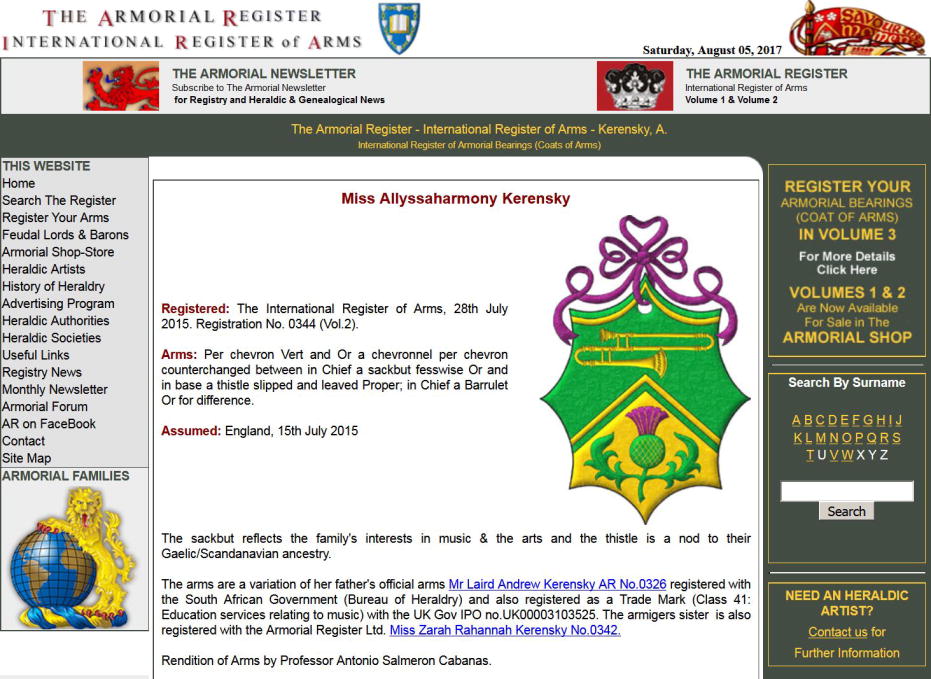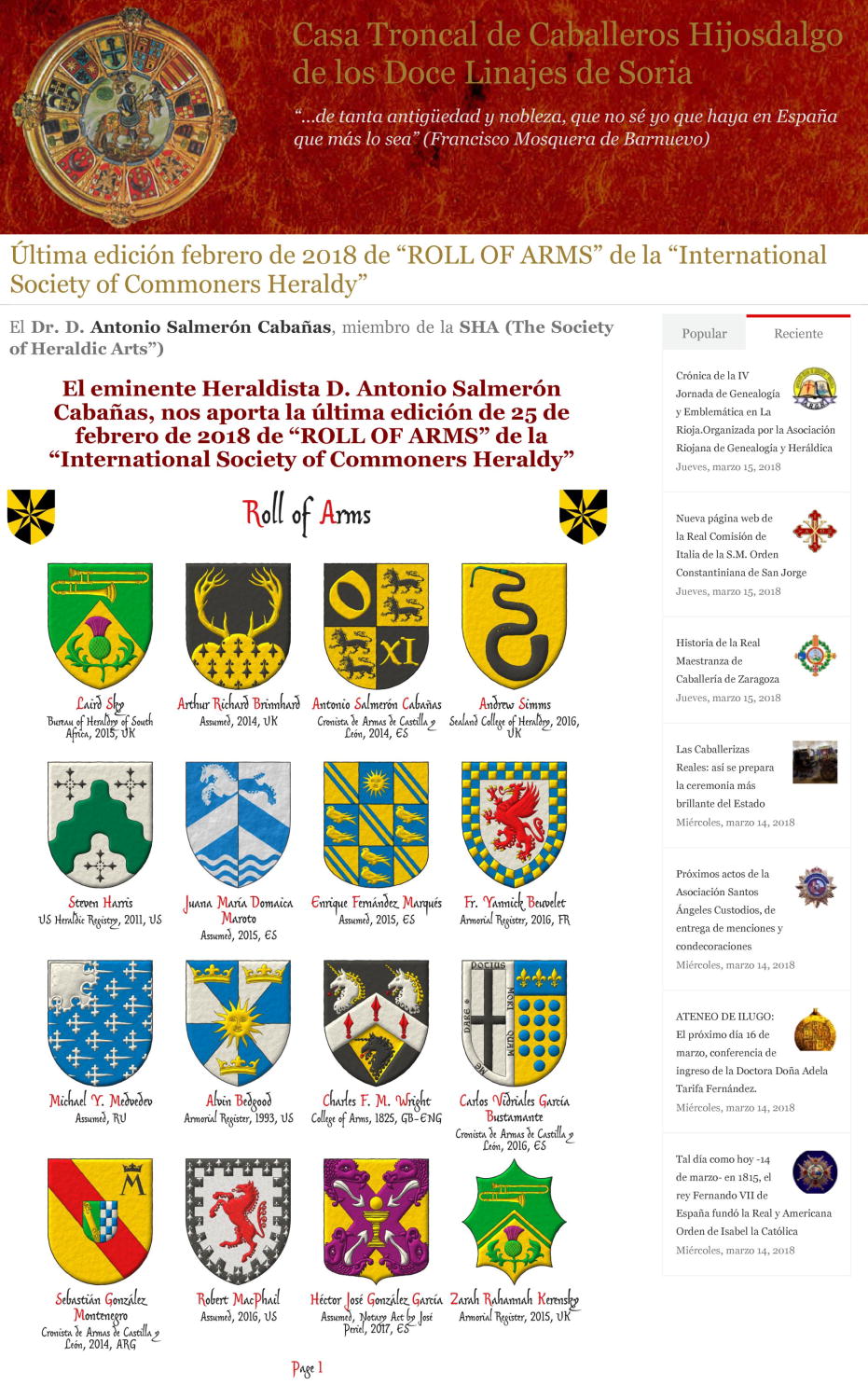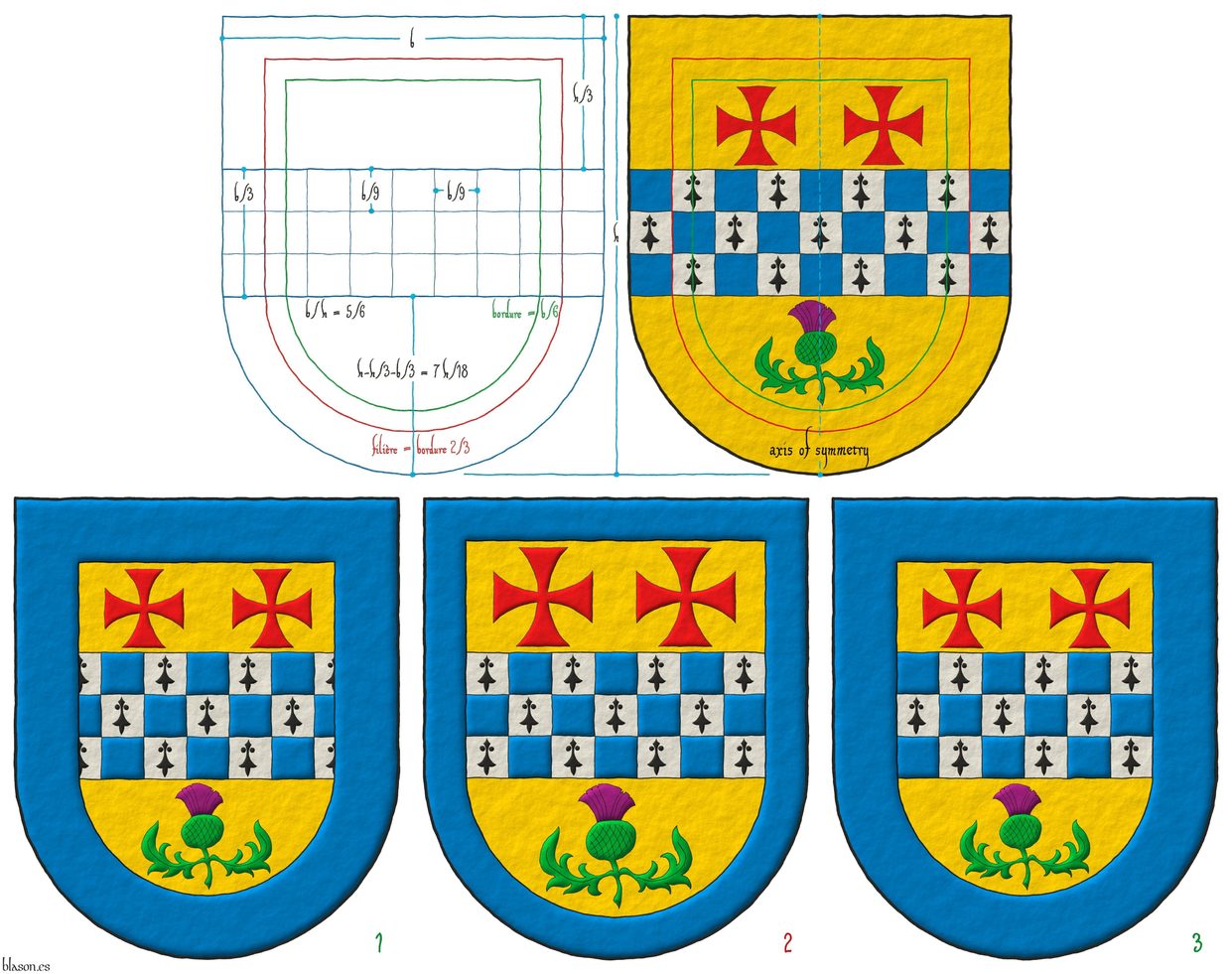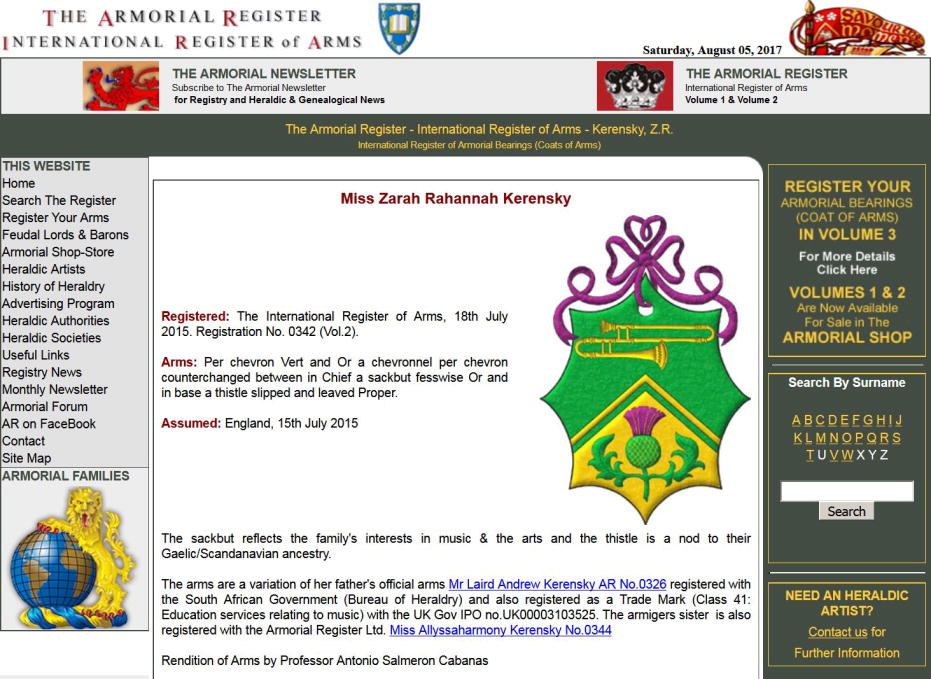Thistle


Allyssaharmony Kerensky, The Armorial Register
Registered by The International Register of Arms, 28th of July of 2015, Registration umber 0344, Volume 2.
Categories: Armorial roll, Vert, Party per chevron, Or, In chief, Sackbut, Fesswise, In base, Thistle, Seeded and Purpure.
Root: The Armorial Register.


![Ver [ISCH Armorial, February 2018 Edition] en enlaces recomendados. Áncora de oro y la divisa enlace.](../css/Ancora.Enlace.png)
ISCH Armorial, February 2018 Edition
Publication on the blog Twelve Lineages of Soria about the armorial I produced for the ISCH under the title: The eminent heraldist Mr. Antonio Salmerón Cabañas brings us his latest edition of February 25, 2018 of the Roll of Arms of the International Society of Commoners Heraldry ISCH.
This armorial contains coats of arms painted by different heraldic artists, although all those shown in the illustration heading this article were painted by my own hand.
Categories: Link, Gules, Azure, Vert, Sable, Purpure, Or, Argent, Without divisions, Gyronny, Party per pale, Quarterly, Bend, Saltire, Bordure, Chevron, Cross, Pile, Bendlet, Inescutcheon, Chequey, Hurt, torteau, pellet, pomme and golpe, Cadency, Thistle, Fleur de lis, Horse, Crown, Sun in splendour, Martlet, Wolf, Letter, Unicorn, Griffin, Dragon's head and Engouled.
Root: Twelve Lineages of Soria.


John Stuart, schema 2x3
Or, a fess chequey Argent, charged with an ermine spot, and Azure, between in chief two cross patty Gules, in base a thistle proper; a diminished bordure Azure.
The coat of arms of Reverend John Stuart, XVIII century, emblazoned by me in 3 approaches: 1) Classic bordure: Using a bordure with a width equal to 1/6 of the coat of arms' base. In the image, this is marked with texts and lines in Vert. Notice that the squares in columns 2 and 8 are split by the inner border of the bordure, which is unfortunate as it disrupts the design. 2) Diminished bordure: Using a narrower bordure with a width equal to 2/3 of the classic bordure, corresponding to 1 square of the fess chequey. In the image, this is marked with texts and lines in Gules. This approach avoids splitting any squares, allows for larger figures, and is my preferred solution. In England, diminished bordures, often simply blazoned as bordure, are more common than in Castile. 3) Without squares splitted: Retaining the classic bordure but shifting the fess chequey 1/2 square to either dexter or sinister to prevent splitting squares. However, this sacrifices the symmetry of the design. This last adjustment was used in the hatchment of Reverend John Stuart in St. George's Cathedral, Kingston, Ontario, 1785.
Blazon keywords: Or, Argent, Azure, One, Three, Nine, Two, Fess, Chequey, Charged, Ermine spot, Between, In chief, Cross, Patty, In base, Thistle, Proper and Diminished bordure.
Style keywords: Ratio, Outlined in sable, Illuminated, Semi-circular and Freehand.
Classification: Personal, Interpreted, Schema, Boa and Coat of arms.
Bearer: Stuart, John.


Laird Sky
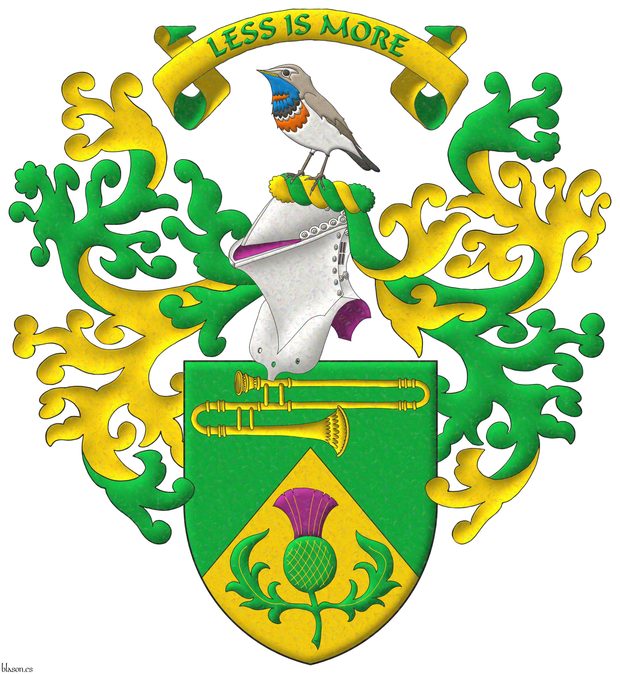
Party per chevron Vert and Or, in chief a sackbut fesswise Or, in base a thistle slipped and leaved proper. Crest: Upon a helm, with a wreath Or and Vert, a bluethroat (Luscinia svecica) proper. Mantling: Vert doubled Or. Motto above the crest: «Less Is More».
Illuminated, an irisdiscent finishing, and the inner of the thistle is outlined in the metal Or of its field.
Blazon keywords: Vert, Party per chevron, Or, In chief, Sackbut, Fesswise, In base, Thistle, Leaved, Slipped, Proper, Motto, Crest and mantling, Helm, Mantling, Wreath and Crest.
Style keywords: Iridescent (nacar), Outlined in sable, Outlined in the field tincture, Illuminated and Pointed.
Classification: Personal, Interpreted, Grant of arms, Heraldic document and Coat of arms.
Bearer: Sky, Laird.


Sky, Laird
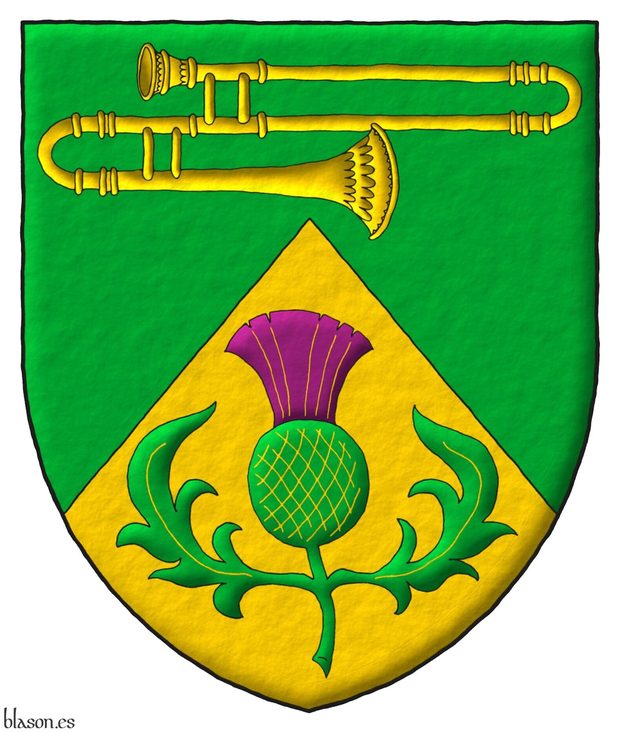
Party per chevron Vert and Or, in chief a sackbut fesswise Or, in base a thistle slipped and leaved proper.
Escudo de sinople, mantelado en punta de oro, en jefe un sacabuche de oro puesto en faja, en punta un cardo de sinople, florido de púrpura.
Illuminated, freehand finishing, and the inner of the thistle is outlined in the metal Or of its field.
Note the different way of writing the blazon in English and Castilian, «...a thistle slipped and leaved proper» ~ «...un cardo de sinople, florido de púrpura».
Blazon keywords: Vert, Party per chevron, Or, In chief, Sackbut, Fesswise, In base, Thistle, Leaved, Slipped and Proper.
Style keywords: Freehand, Outlined in sable, Outlined in the field tincture, Illuminated and Pointed.
Classification: Personal, Interpreted and Coat of arms.
Bearer: Sky, Laird.


Stuart, John

Or, a fess chequey Argent, charged with an ermine spot, and Azure, between in chief two cross patty Gules, in base a thistle proper; a diminished bordure Azure.
Escudo de oro, una faja ajedrezada de plata, cargada de una cola de armiño, y azur, acompañada en jefe de dos cruces patadas de gules, en base de un cardo al natural; una filiera de azur.
Coat of arms painted by me, highlighted with lights and shadows, outlined in Sable, with a semi-circular outer contour and with a watercolor finish.
Coat of arms of Reverend John Stuart, XVIII century, emblazoned by me.
Blazon keywords: Or, Argent, Azure, One, Three, Nine, Two, Fess, Chequey, Charged, Ermine spot, Between, In chief, Cross, Patty, In base, Thistle, Proper and Diminished bordure.
Style keywords: Outlined in sable, Illuminated, Semi-circular and Watercolor.
Classification: Personal, Interpreted, Boa and Coat of arms.
Bearer: Stuart, John.


The American College of Heraldry, blazon
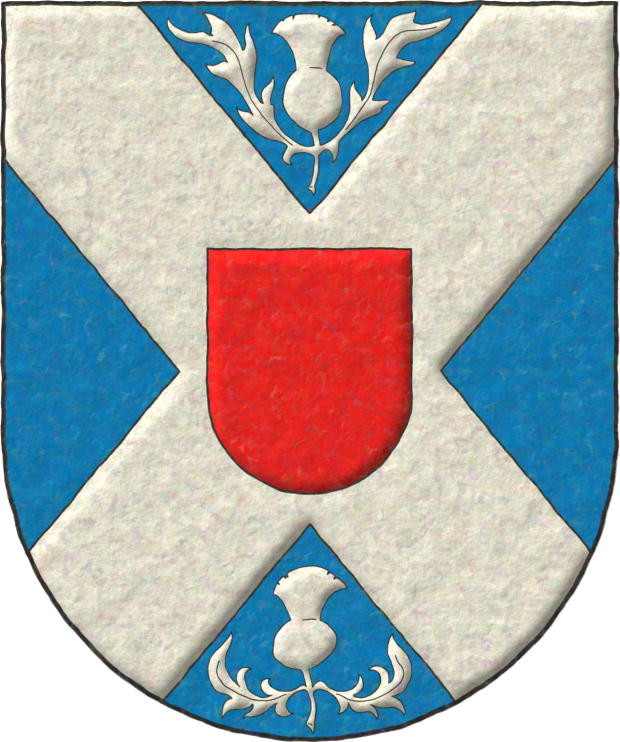
Azure, a saltire between, in chief and in base, two thistle couped Argent; an inescutcheon Gules.
Escudo de azur, un sotuer acompanado, en jefe y en punta, de dos cardos de nuridos todo de plata; un escusón de gules.
Coat of arms interpreted with the following characteristics: the shape of its shield is semicircular; the field is a flat tint of Azure; the two thistles and the saltire are illuminated of the metal Argent and outlined in Sable; the inescutcheon is illuminated of the colour Gules and, also, outlined in Sable; and the whole with a mother-of-pearl finish with a raised stroke.
Inescutcheon ~ escusón
The English term «inescutcheon» corresponds to our Spanish term «escusón». It is called an inescutcheon when there is only one and it is placed in the abyss of the shield.
Escutcheon ~ escudete
The English term «escutcheon» corresponds to our Spanish term «escudete». It is used when there are several, for example, 3. Although in this case there is only one, this is the term used in the official blazon of this coat of arms, as will be seen below.
Thistle ~ cardo
This coat of arms of The Heraldry Society of Scotland was registered and granted ~ «granted» on 7th September 1977, by «The Court of the Lord Lyon», which is the official college of arms for Scotland, lyon-court.com, with the following blazon: «Azure, on a saltire argent between two thistles slipped argent, one in chief and one in base, an escutcheon gules» and it contains 2 thistles, which is the national flower of Scotland, and a saltire Argent on an Azure field, like the flag of Scotland.
Slipped ~ nurido
The usual way of representing the thistle ~ «thistle» in Castile is with its roots visible, it is called «arrancado». In this case the stem is cut and its roots are not visible, it is called «slipped» ~ «nurido».
Blazon keywords: Without divisions, Azure, Saltire, Argent, Thistle, Couped (tree), In chief, In base, Inescutcheon and Gules.
Style keywords: Illuminated, Outlined in sable, Iridescent (nacar), Freehand and Semi-circular.
Classification: Interpreted, Socioeconomic and Coat of arms.
Bearer: The Heraldry Society of Scotland.


![Ver [The Heraldry Society of Scotland] en instituciones citadas. Fortaleza de oro y mazonada de sable.](../css/Fortaleza.Institucion.png)
The Heraldry Society of Scotland

Objectives and activities
The Heraldry Society of Scotland ~ «The Heraldry Society of Scotland», was founded in 1977. Its objectives are to promote the study of heraldry and to encourage its correct use both in Scotland and abroad.
The HSS (acronym for The Heraldry Society of Scotland) encourages those who have a coat of arms and those who intend to adopt their own arms to become members of the society and also encourages to join all those interested in Scottish heraldry, therefore the HSS admits and has members from all over the world.
The HSS holds active and regular meetings throughout the year and organizes conferences and visits to places of historical and heraldic interest, both within Scotland and in other countries.
Online content
They also maintain and update a website, whose domain is Heraldry-Scotland.co.uk, with interesting and abundant reading material, among which their list of online armorials with blazons in English stands out, among which the following armorials can be highlighted:
- Sir David Lindsay's Armorial from 1542, with 504 coats of arms and identification letters «DL», from «DL001» to «DL504». Includes imaginary coats of arms, for example, that of «DL011» of Hector of Troy which it imagines as «Sable, two lions combatant Or», which [Avilés, J.; 1725a; page 7] blazons with a Gules field, this difference would allow tracing the sources of each author, which would be interesting as it is, moreover, imaginary.
- Hamilton Armorial, from 1560, with 82 coats of arms they say, although only 79 appear, and identification letters «HM», from «HM001» to «HM079», where for example, «HM001» is the arms of Scotland «Or, a lion rampant Gules armed and langued Azure within a double tressure flory counter-flory Gules» and «HM026» is the insignia of Scotland «Or, a lion rampant within a double tressure flory counter-flory Gules».
- Queen Mary's Roll from 1562, with 204 coats of arms and identification letters «QM». from «QM001» to «QM204».
- Forman's Armorial from 1563, with 258 coats of arms they say, although only 247 appear, and identification letters «FAL», that is, from «FAL001», the arms of Scotland, to «FAL247».
- Slains Armorial from 1565, with 712 coats of arms they say, although only 638 appear, and identification letters «SL», that is, from «SL001» to «SL638».
- Armorial of Sir David Lindsay of the Mount, Secundus from 1599, with 285 coats of arms and identification letters «DLS».
- Seton Armorial from 1599, with 422 coats of arms and identification letters «SN», from «SN001» to «SN422».
- Dunvegan Armorial estimated to be around 1600, with 282 coats of arms they say, although only 52 appear, and identification letters «DV», only 2 digits and without leading zeros, from «DV1» to «DV52».
- Kings and Nobilities Arms, 2nd volume from 1638, with 111 coats of arms and identification letters «KNB», from «KNB001», the arms of the King of Scotland, to «KNB111».
- Nisbet's A System of Heraldry published in 1722, with 2,608 coats of arms, according to my count, and which I reference as [Nisbet, A.; 1722], 1st edition and [Nisbet, A.; 1816], for a later one that I have available. On the same page appears the blazon of Alexander Nisbet himself, in entry 1,926 according to my calculations, as «Argent, three boars' heads erased Sable within a bordure invected Gules», that is, «Argent: three boars' heads erased Sable; a bordure invected Gules» where «invected» ~ «acanalado» as opposed to «engrailed» ~ «angrelado».
I also find very interesting, for example, their pages on the basic principles of heraldic design, written by Doctor Patrick Barden.
Categories: Institution, Interpreted, Socioeconomic, Illuminated, Outlined in sable, Iridescent (nacar), Freehand, Semi-circular, Coat of arms, Without divisions, Azure, Saltire, Argent, Thistle, Couped (tree), In chief, In base, Inescutcheon and Gules.


Zarah Rahannah Kerensky, The Armorial Register
Registered by The International Register of Arms, 18th of July of 2015, Registration number 0342, Volume 2.
Categories: Armorial roll, Vert, Party per chevron, Or, In chief, Sackbut, Fesswise, In base, Thistle, Seeded and Purpure.
External link:
Root: The Armorial Register.
-
Language
-
Categories of heraldry
-
Divisions of the field
- Without divisions
- Party per pale
- Party per fess
- Party per bend
- Party per bend sinister
- Tierce
- Tierce sinister
- Tierced per pale
- Tierced per fess
- Tierced per bend
- Tierced pallwise inverted
- Quarterly
- Quarterly per saltire
- Gyronny
- Party per fess, the chief per pale
- Party per pale, the sinister per fess
- Party per fess, the base per pale
- Party per pale, the dexter per fess
- Chapé
- Chaussé
- Embrassé
- Contre-embrassé
- Party per chevron
- Enté
- Enté en point
- Flanched
-
Metals
-
Colours
-
Furs
-
Other tinctures
-
Ordinaries and sub-ordinaries
-
Diminutives of the ordinaries
-
Other charges
-
Charges from Nature
Water, Eagle, Bald eagle, Eagle claw, Dorsal fin, Tail fin, Two hands clasped, Lark, Tree, Trunk, Rainbow, Atom, Barbel, Acorn, Bighorn sheep, Arm, Owl, Vulture, Horse, Head, Goat, Camellia, Thistle, Merino ram, Kapok tree, Stag, Doe, Crescent, Increscent, Chrysanthemum, Tail, Tail addorsed, Ermine spot, Hummingbird, Snowflake, Heart, Roe deer, Neck, Stags' attires, Roe deers' attires, Raven, Dolphin, Diamond, Tooth, Elephant, Trunk (elephant), Beetle, Emerald, Starling, Mullet, Mullet of four points, Star of David, Estoile, Male figure, Fleur de lis, Flower, Cornflower, Dogwood flower, Lotus flower, Hop cone, Bluebonnet, Puffin, Ash, Rooster, Claw, Talon, Goose, Heron, Seagull, Pomegranate, Sunflower, Swallow-tail, Falcon, Leaf, Boar, Goldfinch, Laurel, Barn owl, Lion, Lioness, Lion passant, Leopard, Lion rampant guardant, Lynx, Lily, Madonna lily, Flame, Wolf, She-wolf, Parrot, Moon, Hand, Apple, Apple tree, Sea, Martlet, Wing, Two wings in vol, Covert, Blackbird, Mount, Trimount, Fly, Wrist, Elm, Olive tree, Orbital, Bear, Palm frond, Palm tree, Dove, Poplar leaf, Panther, Jaguar, Vine, Paw, Forepaw, Foot (palmiped), Foreleg, Peacock, Chest, Pelican, Pelican in her piety, Dog, Brach hound, Warren hound, Fish, Hoof, Beak, Feather, Ostrich feather, Cinquefoil, Quetzal, Branch, Sprig, Frog, Shamrock, Caboshed, Oak, Holm oak, Rose, Double rose, Savage, Serpent, Plough of Ursa Major, Sun, Sun in splendour, Ray of the sun, Lightning flash, River, Stem, Badger, Tyger, Linden, Wheat, Wheat spike, Bull, Tulip, Udder, Escallop and Fox.
-
Artificial charges
Halberd, Plough share, Ace of spades, Anchor, Cyclamor, Torch, Bow, Arch, Harp, Non-classic artifact, Winnowing fan, Crozier, Conductor's baton, Pair of scales, Ship, Oar, Sail, Norman ship, Beret, Grenade, Ecclesiastical cap, Arm vambraced, Knight, Chain, Cup, Covered cup, Monstrance, Bell, Bell tower, Cannon, Cannon dismounted, Cannon port, Carbuncle, Castle, Ribbon, Clarion, Nail, Crucible, Cord, Dagger, Key ward, Turret, With a turret, Armillary sphere, Sword, Federschwert, Sabre, Parchment, Scroll, Skirt, Arrow, Club, Garb, Sheaf of tobacco, Scythe, Gauntlet, Axe, Buckle, Galician granary, Host, Bonfire, Polish winged hussar, Church, Fanon, Oil lamp, Spear, Spear's head, Fleam, Letter, Book, Open book, Closed book, Bookmark, Page, Line, Lantern, Key, Four crescents joined millsailwise, Hammer, Two-handed sword, Menorah, Mortar, Pestle, Number, Knot, Celtic Trinity knot, Water-bouget, Comb, Piano, Millstone, Millrind, Millwheel, Quill, Clay pot, Potent, Bridge, Cuffed, Hourglass, Chess rooks, Compass rose, Rosette of acanthus leaves, Mullet of six points pierced, Broken, Portcullis, Wheel, Wagon-wheel, Symbol, Sackbut, Drum, Geometric solid, Tetrahedron, Tower, Trident, Trumpet, Double vajra and Anvil.
-
Immaterial charges
Angel, Archangel, Basilisk, Heart enflamed, Sacred Heart of Jesus, Paschal lamb, Dragon's head, Dragon, Wyvern, Phoenix, Garuda, Griffin, Sea-griffin, Winged hand, Our Lady of Mercy, Pegasus, Saint George, Mermaid, Trinity, Triton, Golden fleece, Unicorn and Ouroboros.
-
External elements
-
Heraldic creations
-
References
-
Formats
-
Keywords on this page
Between, Chequey, Proper, Iridescent (nacar), Pointed, Armorial roll, Azure, Boa, Seeded, Thistle, Charged, Ermine spot, Cross, Outlined in sable, Outlined in the field tincture, Two, In chief, In base, Coat of arms, Inescutcheon, Fess, Diminished bordure, Personal, Gules, Leaved, Illuminated, Interpreted, Party per chevron, Semi-circular, Nine, Couped (tree), Or, Patty, Argent, Without divisions, Fesswise, Purpure, Sackbut, Vert, Sky, Laird, Socioeconomic, Saltire, Stuart, John, Slipped, The Armorial Register, The Heraldry Society of Scotland, Freehand, Three and One.
